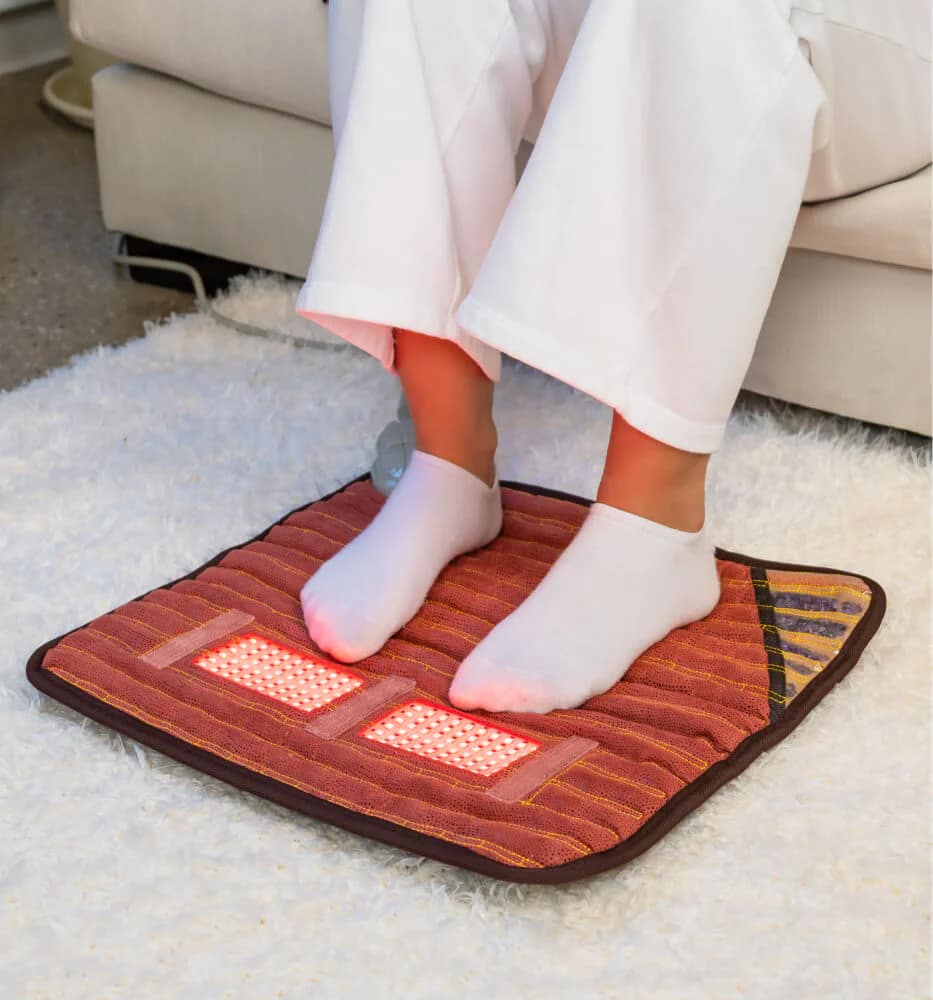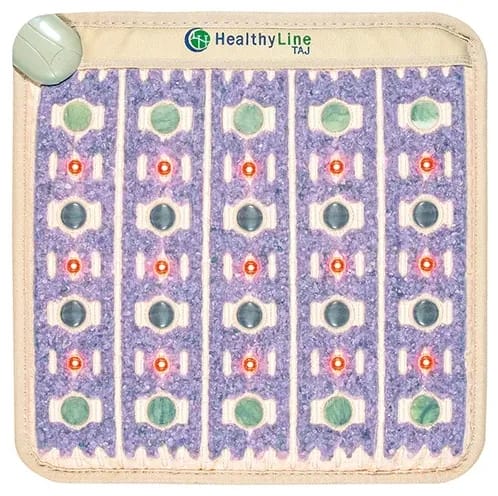PEMF for Arthritis: How It Works, Best Devices & Weekly Plan

Welcome to my article on how to use PEMF for arthritis!
Today, I’ll share my insights on using PEMF therapy to treat arthritis, a condition that affects many people.
Are you aware that around 34% of people with arthritis experience significant mobility issues?
The impact of this condition goes beyond pain, it affects your ability to enjoy daily activities, from walking to holding a cup of coffee.
In this article, I’ll explore how Pulsed Electromagnetic Field (PEMF) therapy helps arthritis. The science behind the PEMF mats benefits for arthritis is pretty solid, and I’ll guide you through it without scientific jargon.
I’ll share my top picks for the best PEMF devices for arthritis. And to make things even easier, I’ll give you a tried-and-true weekly plan at the end so you can ditch the guesswork and smoothly add PEMF treatment into your daily routine.
If you’re looking for drug-free pain relief, keep reading!
🔬PEMF For Arthritis: The Science Behind
At first, the idea of using electromagnetic pulses to heal the body sounds futuristic, almost too good to be true.
But once you understand the science behind it, everything starts to make sense.
🧬 Reinvigorating the Body at a Cellular Level

Imagine your cells as tiny batteries, constantly working to keep your body functioning. Over time, due to stress, aging, and disease, these cellular batteries lose their charge.
PEMF therapy works by sending low-frequency electromagnetic pulses.
A 2023 article published in the International Journal of Molecular Sciences shows that PEMF penetrates deeply into tissues and cells, supporting cellular health and function. It can also influence the cellular environment, helping restore tissue integrity and performance.
While not a proper scientific term, it suggests that PEMF can “recharge” the cells, restoring their natural ability to heal and regenerate.
The article also provides evidence that PEMF can enhance mitochondrial function and ATP production (Adenosine Triphosphate), which is your body’s main energy source, fueling repair, recovery, and overall health. It powers muscle function, cell regeneration, and vital processes, keeping your body running efficiently.
🌿 Reducing Inflammation
Arthritis pain isn’t just about discomfort, it’s about the daily limitations it creates.
Whether it’s stiff fingers that make it hard to grip the leash of your dog or aching knees that turn a short walk into a struggle, chronic inflammation and joint degeneration are the real culprits.
A 2019 research published in Bioelectricity suggests that PEMF therapy helps by calming down the inflammatory response and reducing the production of pro-inflammatory cytokines (the chemicals that trigger swelling and pain).
A 2014 study published in the Journal of Inflammation Research found that PEMF therapy can reduce inflammatory markers such as C-reactive protein (CRP), which is often elevated in individuals with chronic pain.
In simple terms, PEMF acts like a reset button for overactive inflammation. The electromagnetic pulses stimulate blood flow to the affected area, helping to flush out toxins and excess fluid that contribute to joint stiffness.
This is why many people with arthritis report feeling looser and more mobile after regular PEMF sessions.

🦴 Stimulating Cartilage Regeneration
A big challenge of arthritis, especially osteoarthritis, is cartilage wear and tear. This breakdown causes bone-on-bone friction over time.
Sadly, cartilage doesn’t heal well. That’s why many people choose joint replacements. But PEMF may offer a way to slow down and even reverse some of this damage.
A 2015 in vitro study on bovine cartilage found that PEMF counteracted the effects of induced cartilage degeneration. The groups treated with PEMF showed near-normal cartilage structure versus severe erosion in the untreated groups.
Another 2023 study conducted on rats with temporomandibular joint osteoarthritis has found that PEMF reversed the decreased cartilage thickness and degraded cartilage extracellular matrix.
While neither of those studies was conducted on humans, they provide evidence that PEMF can support cartilage repair and potentially slow down joint aging.
This can be especially helpful for people looking to avoid or delay surgery.
🦴 Improving Joint Function and Mobility
When you’re dealing with arthritis, it’s not just the pain that gets in the way—it’s the stiffness. Joints can feel tight, swollen, and hard to move, especially after periods of rest.
Over time, this reduced range of motion can lead to even more discomfort, less mobility, and a cycle that’s hard to break.
A 2018 systematic review published in Tissue Engineering analyzed PEMF’s influence on joints and found that “a beneficial effect was observed on improving function in osteoarthritic knees“.
A 2024 randomized clinical trial published in Medicine examining PEMF for early-stage knee osteoarthritis reported gradual improvement in knee joint mobility and decreased pain scores over 12 weeks of treatment.
Better flexibility also means you can move more freely, with less effort and strain on surrounding muscles.
That can reduce the risk of falls, support your posture, and help you keep doing the things you love—whether it’s gardening, walking the dog, or simply getting out of bed with less struggle.
PEMF Therapy for Arthritis: The Bottom Line
I know from experience that these benefits aren’t something that happens overnight. The best results come with consistency. Typically, you’ll start seeing improvements after several sessions.
For many, this can be the difference between feeling stuck and feeling like they have more freedom in their daily movements.
It’s also worth mentioning that PEMF therapy doesn’t replace the need for physical therapy or other treatments.
Instead, it complements them. I always recommend a holistic approach that includes strengthening exercises, good hydration, and, of course, healthy lifestyle habits.
Best PEMF Devices for Arthritis
When it comes to treating arthritis with PEMF, not all devices are the same.
The right choice depends on your specific needs.
First, ask yourself: Do you need targeted relief for a specific joint, or are you looking for full-body treatment?
The answer will help determine which PEMF device is best for you. Let’s break down your options so you can find the perfect fit for lasting arthritis relief.
1. PEMF Mats

PEMF mats provide a convenient, full-body approach to arthritis relief. Just lie down, relax, and let the therapy work on your entire body.
These mats are especially effective when dealing with multiple joint issues, rather than focusing on just one painful area. They’re ideal for those days when arthritis seems to affect everything from your shoulders to your knees.
The downside? PEMF mats tend to be more expensive than targeted devices and are not portable. Most need to be plugged into an outlet, making them better suited for home use.
If you’re looking for an easy, all-encompassing treatment at home, a PEMF mat can be a great investment.
PEMF mats aren’t all created equal. If you’re curious which one is right for you, check out my full review of the Top 26 PEMF Mats of 2025. Below, you’ll find the top 3 picks from that list:

HealthyLine JET

OMI PEMF Beyond

Therasage TheraPro
2. PEMF Pads

If your arthritis mainly affects one area—like achy knees or stiff fingers—a PEMF pad might be your perfect match. These compact devices deliver focused therapy exactly where you need it most.
These smaller options are more budget-friendly than full-size mats.
Since many models offer battery power for true portability, they are easy to pack in a bag or take to work.
The main limitation? You’re only treating one area at a time. But since most arthritis sufferers have specific “hot spots” of pain, these targeted devices often make perfect sense for day-to-day relief.
Is a PEMF pad the solution for you? Then just check my article on the best PEMF pads. It will help you to find the one that suits your needs the best.
Here are the 3 PEMF pads that I consider to be the best to treat arthritis:

HealthyLine TAJ

OmniPEMF NeoRhythm

HealthyLine TAO Matrix
3. PEMF Chair Mats

PEMF chair mats offer a practical middle-ground solution that works while you’re sitting. They’re perfect for treating your back, hips, and thighs as you go about your normal seated activities.
They let you tackle your arthritis pain while answering emails or enjoying your favorite show.
Like full-size mats, chair versions tend to be on the pricier side and need to be plugged in. They’re ideal if you spend significant time sitting and want to make those hours work double-duty for pain relief.
The main limitation is coverage—areas like your feet, lower legs, and neck will miss out on the benefits. But for anyone who spends hours at a desk or in a favorite armchair, a PEMF chair mat could be the perfect fit for your lifestyle.
If you think that a chair mat can be the best solution for your needs, just check out my guide to the 7 best PEMF chair mats! I’m sure you’ll find the right one for you!
Here are my top 3 chair mats to treat arthritis:

HealthyLine JET Chair

HealthyLine Rainbow Chakra Chair

Grooni Earthing PEMF Infrared Mat Pro
4. PEMF Portable Devices & Wearables

PEMF wearables bring laser-focused therapy to specific trouble spots. These compact devices attach directly to problem areas like a tender wrist or achy knee, delivering relief exactly where you need it.
They’re lightweight, battery-powered, and designed to work while you move through your day.
The trade-off is their limited coverage area. They’re designed to treat one specific joint at a time. This means if you have arthritis in both knees or wrists, you’ll either need to purchase two devices or alternate treatment between joints.
These devices are ideal for people with predictable, localized arthritis pain who want a solution that travels easily and doesn’t interrupt daily activities.
Looking to explore more PEMF wearable options? Take a peek at my buying guide covering the best portable PEMF devices and wearables available. You’re bound to discover the perfect device for your specific needs!
When it comes to treating your arthritis with PEMF, I found these 3 wearable devices to be the best:

OmniPEMF NeoRhythm

OMI PEMF PowerBand

Haelo Symphony One
📅 PEMF for Arthritis: My Weekly Schedule (Tried & Tested)
Looking to ease arthritis pain with PEMF therapy? I’ve put together a simple weekly plan to make your treatment easy and effective. This step-by-step guide takes the guesswork out of your journey, providing a clear approach that balances results and safety based on proven protocols.
Are you new to PEMF? Let me quickly explain frequency and intensity:
-
Frequency, measured in Hertz (Hz), refers to the number of electromagnetic pulses delivered per second by a PEMF device. In simple terms, it determines how fast the pulses occur.
-
Intensity represents the strength of the electromagnetic field emitted by the PEMF device. Most devices use Gauss (G) and MicroTesla (µT) in their user manual and controllers or phone apps. So I have included both in the table.
Think of this as your GPS for arthritis relief. Just follow the directions, and you’ll be heading toward your destination! Most people start feeling real improvements within the first couple of weeks when they stick with a consistent routine like this one.
The beauty of having a structured plan is that you don’t have to wonder, “Am I doing this right?” or “How often should I use this thing?” Just follow along, and you’ll be giving your body exactly what it needs to start fighting back against that stubborn arthritis pain.
| Day | Sessions | Frequency | Intensity | Duration | Time of Day |
|---|---|---|---|---|---|
| Monday | 2 | 10 Hz | 200 μT / 2 Gauss | 30 min | Morning & Evening |
| Tuesday | 1 | 5 Hz | 100 μT / 1 Gauss | 45 min | Evening |
| Wednesday | 2 | 15 Hz | 150 μT / 1.5 Gauss | 30 min | Morning & Evening |
| Thursday | Rest | – | – | – | – |
| Friday | 2 | 10 Hz | 200 μT / 2 Gauss | 30 min | Morning & Evening |
| Saturday | 1 | 5 Hz | 100 μT / 1 Gauss | 60 min | Afternoon |
| Sunday | Rest | – | – | – | – |
-
Initial Cycle: Perform the therapy for 6-8 weeks, following the weekly schedule below.
-
Maintenance: After completing the initial cycle, reduce to 3 sessions per week (e.g., Monday, Wednesday, Friday) for maintenance.
Flexible Guidelines for Daily Integration
Don’t like sticking to strict schedules? No worries!
Here’s a more adaptable way to fit PEMF therapy into your everyday life while still getting great results. Think of these as friendly guidelines rather than rigid rules.
The real beauty of this approach is how you can blend PEMF sessions into your natural daily flow.
- Frequency of Use:
- Aim for at least 4-5 sessions per week.
- Alternate between high-frequency days (10-15 Hz) and low-frequency recovery days (5 Hz).
- Intensity:
- Set to an intensity of 100 μT / 1 Gauss to 200 μT / 2 Gauss, depending on comfort and device capability.
- Session Duration:
- Each session should last between 30 and 60 minutes, depending on your availability and symptom severity.
- Time of Day:
- Morning sessions can help reduce stiffness while evening sessions promote relaxation and recovery.
- Combination with Lifestyle Changes:
- Incorporate light exercises like yoga, walking, or swimming on therapy days.
- Follow an anti-inflammatory diet rich in omega-3 fatty acids, and antioxidants, and low in processed foods.
- Rest Days:
- Take at least one or two rest days per week to allow your body to recover naturally.
- Consistency:
- Regular use is key to achieving long-term benefits; sporadic use may not yield the same results.
Some people love morning treatments to kick off their day pain-free, while others prefer evening sessions to help them unwind and sleep better. It’s just like finding your ideal workout time—whatever works best for your body and fits into your schedule is the right answer!
FAQs
While PEMF therapy is generally safe, it’s important to remember that, like any treatment, it can have rare side effects and some contraindications. If you have concerns or specific health conditions, we’ve covered everything in detail in a dedicated article. Be sure to check it out if you’re in doubt!
The time it takes to notice improvements with PEMF therapy can vary depending on how severe your arthritis is and how your body responds to treatment. Some people see significant pain relief and improvements in mobility after a few weeks of consistent use.
PEMF therapy is a non-invasive, drug-free option for managing arthritis symptoms. Unlike medications, which can have side effects, PEMF helps to reduce back pain and improve function by targeting the affected areas directly. It is also widely used to treat plantar fasciitis.
Scientific Evidence

ABOUT THE AUTHOR
Marco Gentile
Marco Gentile (CHC, CMT, CTP, CETS) is a seasoned wellness professional with over 10 years of experience helping clients achieve optimal health and longevity. Currently, he works at the Burke Williams Spa – Health, Wellness & Fitness Center in L.A., where he continues to inspire and support individuals on their wellness journeys.







